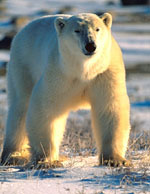The place to watch for global warming — the sensitive point, the canary in the coal mine — is the Arctic. If the planet as a whole warms by one degree, the poles will warm by about three degrees. Which is just what is happening.

Polar bears are walking on thin ice.
Ice now covers 15 percent less of the Arctic Ocean than it did 20 years ago. In the 1950s that ice averaged 10-feet thick; now it’s less than six-feet thick. At the current rate of melting, in 50 years the northern ocean could be ice-free all summer long.
That, says a January 19 article in Science, would be the end of polar bears. In fact many creatures of the Arctic Ocean are already in trouble.
Until recently no one knew that there were many creatures of the Arctic Ocean. In the 1970s, a Russian biologist named Melnikov discovered 200 species of tiny organisms, algae and zooplankton, hanging around ice floes in immense numbers, forming slime jungles on the bottoms of bergs and plankton clouds in every break of open water. Their carcasses fall to the bottom to nourish clams, which are eaten by walruses. Arctic cod live on algae scraped off the ice. The cod are eaten by seabirds, whales, and seals. The king of the food chain, hunting mainly seals, is the great white bear.
That was the system until the ice started to thin. In 1997 and 1998 Melnikov returned to the Beaufort Sea and found most of the plankton species, many named by him (and for him), were gone. The ice was nearly gone. Creatures dependent on the plankton (like the cod), or on the ice for dens (seals), or for travel (bears) were gone, too.
Many had just moved north, following the ice, but that means moving farther from land, with widening stretches of open water between. Creatures like the black guillemot, a bird that depends on land for shelter and the ice floe for food, can no longer bridge the gap.
The Arctic is changing faster than scientists can document. Inuit hunters report that ivory gulls are disappearing; no one knows why. Mosquitoes are moving north, attacking murres, which will not move from their nests, so they are literally sucked and stung to death. Caribou can no longer count on thick ice to support their island-hopping in search of the lichens that sustain them. One biologist who spots caribou from the air says, “You sometimes see a caribou trail heading across [the ice], then a little wormhole at the end with a bunch of antlers sticking out.”
Hudson’s Bay polar bears are thinner and are producing fewer cubs. With the ice going out earlier, their seal-hunting season is shrinking. Hungry bears retreat to land and ransack garbage dumps. The town of Churchill in Canada has more jail cells for bears than for people. The bears are also weakened by toxic chemicals that drift north from industrial society and accumulate in the Arctic food chain.
Every five years the world’s climatologists assess current knowledge about global warming. Their latest report was just released. It erases any doubt about where this warming is coming from and warns that we ain’t seen nothing yet. If we keep spewing out greenhouse gases according to pattern, we will see three to 10 times more warming over the 21st century than we saw over the 20th.
Some biologists are saying the polar bear is doomed.
A friend of mine, in response to this news, did the only appropriate thing. She burst out weeping. “What am I going to tell my three-year-old?” She sobbed. Any of us still in contact with our hearts and souls should be sobbing with her, especially when we consider that the same toxins that are in the bears are in the three-year-old. And that the three-year-old over her lifetime may witness collapsing ecosystems, north to south, until all creatures are threatened, especially top predators like polar bears and people.
Is there any way to end this column other than in gloom? Can I give my friend, you, myself any honest hope that our world will not fall apart? Does our only possible future consist of watching the disappearance of the polar bear, the whale, the tiger, the elephant, the redwood tree, the coral reef, while fearing for the three-year-old?
Heck, I don’t know. There’s only one thing I do know. If we believe that it’s effectively over, that we are fatally flawed, that the most greedy and short-sighted among us will always be permitted to rule, that we can never constrain our consumption and destruction, that each of us is too small and helpless to do anything, that we should just give up and enjoy our SUVs while they last — well, then yes, it’s over. That’s the one way of believing and behaving that gives us a guaranteed outcome.
Personally, I don’t believe that stuff at all. I don’t see myself or the people around me as fatally flawed. Everyone I know wants polar bears and three-year-olds in our world. We are not helpless and there is nothing wrong with us except the strange belief that we are helpless and there’s something wrong with us. All we need to do, for the bear and ourselves, is to stop letting that belief paralyze our minds, hearts, and souls.

